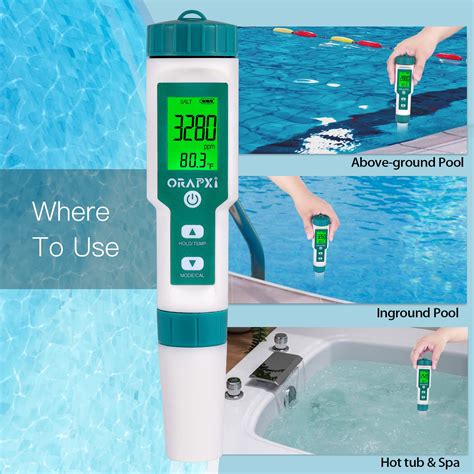Maintaining a sparkling clean swimming pool is essential for a refreshing and safe summer experience. One crucial element in pool maintenance is ensuring the optimal salt level in the water. A digital pool salt tester provides an accurate and convenient way to monitor and adjust salt concentration, allowing you to keep your pool water balanced and inviting.

Why Test Pool Salt Levels?
When the salt level in your pool water is too low, the chlorine generator cannot produce sufficient chlorine to sanitize the water effectively. This can lead to algae growth, murky water, and unpleasant odors. Conversely, excessive salt levels can irritate skin and eyes, corrode pool equipment, and make the water feel uncomfortably salty.
Benefits of a Digital Pool Salt Tester
Unlike traditional test strips, digital pool salt testers offer several advantages:
- Accuracy: Provides precise readings, typically within a margin of error of 0.1 ppm (parts per million).
- Convenience: Easy to use, with clear digital display and no need for reagents or color matching.
- Time-Saving: Gives instant results, eliminating the wait time associated with test strips.
- Durability: Robust construction ensures longevity and withstands frequent use.
How to Use a Digital Pool Salt Tester
- Calibrate the tester according to the manufacturer’s instructions.
- Fill a clean container with a sample of pool water.
- Insert the probe into the water sample and press the “Measure” button.
- The digital display will show the salt level reading in ppm.
Ideal Pool Salt Level
The optimal salt level for a swimming pool ranges from 2,500 to 4,000 ppm. The specific level depends on the type of chlorine generator and the size of the pool. It is advisable to consult your pool manufacturer or a qualified pool professional for guidance.
Common Mistakes to Avoid
- Using the tester in direct sunlight, as UV rays can interfere with the readings.
- Measuring salt levels immediately after adding salt to the pool. Allow the salt to dissolve and mix thoroughly before testing.
- Ignoring the need to calibrate the tester regularly. Calibration ensures accurate readings over time.
Applications of Digital Pool Salt Testers
Beyond routine pool maintenance, digital pool salt testers have a wide range of applications:
- Salinity Monitoring in Aquariums: Maintaining precise salt levels is crucial for the health of marine life.
- Water Softener Performance Evaluation: Digital salt testers can help assess the effectiveness of water softeners in removing calcium and magnesium ions.
- Hydroponic Systems: Salt levels in hydroponic nutrient solutions need to be controlled for optimal plant growth.
- Industrial Wastewater Monitoring: Industries that use salt in their processes can monitor salt concentrations in wastewater to meet environmental regulations.
Conclusion
A digital pool salt tester is an essential tool for maintaining the optimal salt level in swimming pools. Its accuracy, convenience, and durability make it the preferred choice for pool owners seeking crystal clear water and a safe and enjoyable swimming experience. By using a digital salt tester regularly, you can prevent common pool water issues, extend the lifespan of your pool equipment, and create a refreshing oasis for summer fun.
